Sunshine Duration Variability in Haihe River Basin, China, during 1966–2015
Abstract
:1. Introduction
2. Study Area and Methods
Study Area and Data
3. Results
3.1. Temporal Change of Sunshine Duration
3.1.1. Annual Sunshine Duration
3.1.2. Seasonal Sunshine Duration
3.1.3. Monthly Sunshine Duration
3.2. Spatial Change of Sunshine Duration
3.3. Relationship of Sunshine Duration with Temperature and Wind Speed
4. Discussion
5. Conclusions
Acknowledgments
Author Contributions
Conflicts of Interest
References
- Ranzi, R.; Rosso, R. Distributed estimation of incoming direct solar radiation over a drainage basin. J. Hydrol. 1995, 166, 461–478. [Google Scholar] [CrossRef]
- Yang, Y.H.; Zhao, N.; Hao, X.H.; Li, C.Q. Decreasing trend of sunshine hours and related driving forces in North China. Theor. Appl. Climatol. 2009, 97, 91–98. [Google Scholar] [CrossRef]
- Lenuta, M.; Marius-Victor, B.; Roxana, B.; Alexandru, D.; Magdalena, M.D.; Ancuta, M. An overview of annual climatic changes in Romania: Trends in air temperature, precipitation, sunshine hours, cloud cover, relative humidity and wind speed during the 1961–2013 period. Carpathian J. Earth Environ. 2014, 9, 253–258. [Google Scholar]
- Dobesch, H. On the variations of sunshine duration in Austria. Theor. Appl. Climatol. 1992, 46, 33–38. [Google Scholar] [CrossRef]
- Sanchez-Lorenzo, A.; Calbo, J.; Martin-Vide, J. Spatial and Temporal Trends in Sunshine Duration over Western Europe (1938–2004). J. Clim. 2008, 21, 6089–6098. [Google Scholar] [CrossRef]
- Matuszko, D.; Weglarczyk, S. Relationship between sunshine duration and air temperature and contemporary global warming. Int. J. Climatol. 2015, 35, 3640–3653. [Google Scholar] [CrossRef]
- Xu, Z.; Zhao, F. Variation of Sunlight Radiation Duration in the Yellow River Basin. Resour. Sci. 2005, 27, 153–159. (In Chinese) [Google Scholar]
- Zhang, L.; Lou, W. Temporal and spatial variations of sunshine duration and its influence factors in lower-middle reach of the Changjiang River in recent 50 years. Resour. Environ. Yangtze Basin 2013, 5, 595–601. (In Chinese) [Google Scholar]
- Zhang, M.; Shan, F.; Sheng, Y. Analysis on the Variation Characteristics of Sunshine Hours in Puyang City. Meteorol. Environ. Res. 2011, 2, 23–26. [Google Scholar]
- Zheng, X.; Kang, W.; Zhao, T.; Luo, Y.; Duan, C.; Chen, J. Long-term trends in sunshine duration over Yunnan-Guizhou Plateau in Southwest China for 1961–2005. Geophys. Res. Lett. 2008, 35. [Google Scholar] [CrossRef]
- Kaiser, D.P.; Qian, Y. Decreasing trends in sunshine duration over China for 1954–1998: Indication of increased haze pollution? Geophys. Res. Lett. 2002, 29, 38-1–38-4. [Google Scholar] [CrossRef]
- Lobell, D.B.; Asner, G.P. Climate and management contributions to recent trends in U.S. agricultural yields. Science 2003, 299, 1032. [Google Scholar] [CrossRef] [PubMed]
- Deng, N.; Ling, X.; Sun, Y.; Zhang, C.; Fahad, S.; Peng, S.; Cui, K.; Nie, L.; Huang, J. Influence of temperature and solar radiation on grain yield and quality in irrigated rice system. Eur. J. Agron. 2015, 64, 37–46. [Google Scholar] [CrossRef]
- Hu, S.; Mo, X.; Lin, Z. The contribution of climate change to the crop phenology and yield in Haihe River Basin. Geogr. Res. 2014, 33, 3–12. (In Chinese) [Google Scholar]
- Chu, J.T.; Xia, J.; Xu, C.; Singh, V.P. Statistical downscaling of daily mean temperature, pan evaporation and precipitation for climate change scenarios in Haihe River, China. Theor. Appl. Climatol. 2010, 99, 149–161. [Google Scholar] [CrossRef]
- Mann, H.B. Nonparametric Tests against Trend. Econometrica 1945, 13, 245–259. [Google Scholar] [CrossRef]
- Kendall, M.G. Rank Correlation Methods; Charles Griffin: London, UK, 1975. [Google Scholar]
- Zhang, Q.; Xu, C.; Becker, S.; Jiang, T. Sediment and runoff changes in the Yangtze River basin during past 50 years. J. Hydrol. 2006, 331, 511–523. [Google Scholar] [CrossRef]
- Yue, S.; Pilon, P.; Cavadias, G. Power of the Mann-Kendall and Spearman’s rho tests for detecting monotonic trends in hydrological series. J. Hydrol. 2002, 259, 254–271. [Google Scholar] [CrossRef]
- Fisher, R.A. Statistical Methods, Experimental Design, and Scientific Inference; Oxford University-Press: New York, NY, USA, 1990. [Google Scholar]
- Bartier, P.M.; Keller, C.P. Multivariate interpolation to incorporate thematic surface data using inverse distance weighting (IDW). Comput. Geosci. 1996, 22, 795–799. [Google Scholar] [CrossRef]
- Urraca, R.; Martinez-de-Pison, E.; Sanz-Garcia, A.; Antonanzas, J.; Antonanzas-Torres, F. Estimation methods for global solar radiation: Case study evaluation of five different approaches in central Spain. Renew. Sustain. Energy Rev. 2017, 77, 1098–1113. [Google Scholar] [CrossRef]
- Rodríguez-Amigo, M.D.C.; Díez-Mediavilla, M.; González-Peña, D.; Pérez-Burgos, A.; Alonso-Tristán, C. Mathematical interpolation methods for spatial estimation of global horizontal irradiation in Castilla-León, Spain: A case study. Sol. Energy 2017, 151, 14–21. [Google Scholar] [CrossRef]
- Zhang, Y.L.; Qin, B.Q.; Chen, W.M. Analysis of 40 year records of solar radiation data in Shanghai, Nanjing and Hangzhou in Eastern China. Theor. Appl. Climatol. 2004, 78, 217–227. [Google Scholar] [CrossRef]
- You, Q.; Kang, S.; Flügel, W.A.; Sanchez-Lorenzo, A.; Yan, Y.; Huang, J.; Martin-Vide, J. From brightening to dimming in sunshine duration over the eastern and central Tibetan Plateau (1961–2005). Theor. Appl. Climatol. 2010, 101, 445–457. [Google Scholar] [CrossRef]
- Liepert, B.G.; Kukla, G.J. Decline in Global Solar Radiation with Increased Horizontal Visibility in Germany between 1964 and 1990. J. Clim. 1997, 10, 2391–2401. [Google Scholar] [CrossRef]
- Stanhill, G. Long-term trends in, and spatial variation of, solar irradiances in Ireland. Int. J. Climatol. 1998, 18, 1015–1030. [Google Scholar] [CrossRef]
- Liepert, B.G. Observed reductions of surface solar radiation at sites in the United States and worldwide from 1961 to 1990. Geophys. Res. Lett. 2002, 29, 61-1–61-4. [Google Scholar] [CrossRef]
- Xu, M.; Chang, C.P.; Fu, C.; Qi, Y.; Robock, A.; Robinson, D.; Zhang, H.M. Steady decline of East Asian monsoon winds, 1969–2000: Evidence from direct ground measurements of wind speed. J. Geophys. Res. 2006, 111, D24111. [Google Scholar] [CrossRef]
- Moorthy, K.K.; Satheesh, S.; Murthy, B.V.K. Characteristics of spectral optical depths and size distributions of aerosols over tropical ocean regions. J. Atmos. Sol. Terr. Phys. 1998, 60, 981–992. [Google Scholar] [CrossRef]
- O’Dowd, C.D.; Smith, M.H. Physicochemical properties of aerosols over the northeast Atlantic: Evidence for wind-speed-related submicron sea-salt aerosol production. J. Geophys. Res. 1993, 98, 1137–1149. [Google Scholar] [CrossRef]
- Kumar, P.; Fennell, P.; Britter, R. Effect of wind direction and speed on the dispersion of nucleation and accumulation mode particles in an urban street canyon. Sci. Total Environ. 2008, 402, 82–94. [Google Scholar] [CrossRef] [PubMed] [Green Version]
- Satheesha, S.K.; Moorthy, K.K. Radiative effects of natural aerosols: A review. Atmos. Environ. 2005, 39, 2089–2110. [Google Scholar] [CrossRef]
- Zongxing, L.; Qi, F.; Wei, Z.; Yuanqing, H.; Xufeng, W.; Catto, N.; Meng, H. Decreasing trend of sunshine hour and related driving forces in Southwestern China. Theor. Appl. Climatol. 2012, 109, 305–321. [Google Scholar] [CrossRef]
- Ren, G.Y.; Chu, Z.Y.; Chen, Z.H.; Ren, Y.Y. Implications of temporal change in urban heat island intensity observed at Beijing and Wuhan stations. Geophys. Res. Lett. 2007, 34, L05711. [Google Scholar] [CrossRef]
- Fang, S.; Qi, Y.; Yu, W.; Liang, H.; Han, G.; Li, Q.; Shi, G. Change in temperature extremes and its correlation with mean temperature in mainland China from 1960 to 2015. Int. J. Climatol. 2017, 37, 3910–3918. [Google Scholar] [CrossRef]
- Alexander, L.; Allen, S.; Bindoff, N.L.; Breon, F.M.; Church, J.; Cubasch, U.; Emori, S.; Forster, P.; Friedlingstein, P.; Gillett, N.; et al. Climate Change 2013: The Physical Science Basis Summary for Policymakers; IPCC WGI Fifth Assessment Report; IPCC: Geneva, Switzerland, 2013.
- Wang, Y.; Yang, Y.; Zhao, N.; Liu, C.; Wang, Q. The magnitude of the effect of air pollution on sunshine hours in China. J. Geophys. Res. Atmos. 2012, 117. [Google Scholar] [CrossRef]
- Liu, C.; Liu, X.; Zheng, H.; Yan, Z. Change of the solar radiation and its causes in the Haihe River Basin and surrounding areas. J. Geogr. Sci. 2010, 20, 569–580. [Google Scholar] [CrossRef]
- Palle, E.; Butler, C.J.; O’Brien, K. The possible connection between Ionisation in the Atmosphere by Cosmic Rays and Low-level Clouds. J. Atmos. Sol. Terr. Phys. 2004, 66, 1779–1790. [Google Scholar] [CrossRef]
- Kaiser, D.P. Analysis of total cloud amount over China, 1951–1994. Geophys. Res. Lett. 1998, 25, 3599–3602. [Google Scholar] [CrossRef]
- Qian, Y.; Kaiser, D.P.; Leung, L.R.; Xu, M. More frequent cloud-free sky and less surface solar radiation in China from 1955 to 2000. Geophys. Res. Lett. 2006, 33, L01812. [Google Scholar] [CrossRef]
- Albrecht, B.A. Aerosols, Cloud Microphysics, and Fractional Cloudiness. Science 1989, 245, 1227–1230. [Google Scholar] [CrossRef] [PubMed]
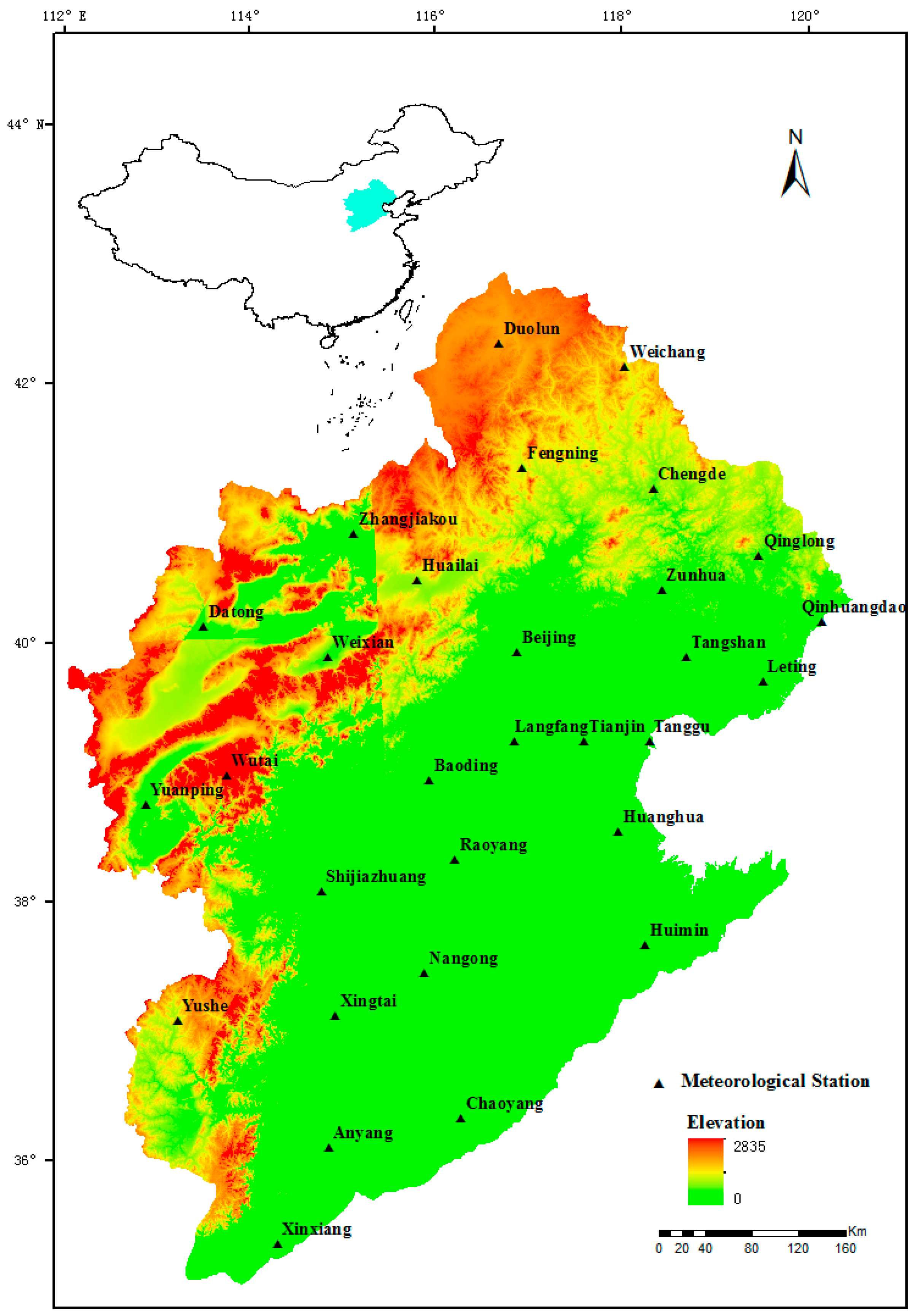
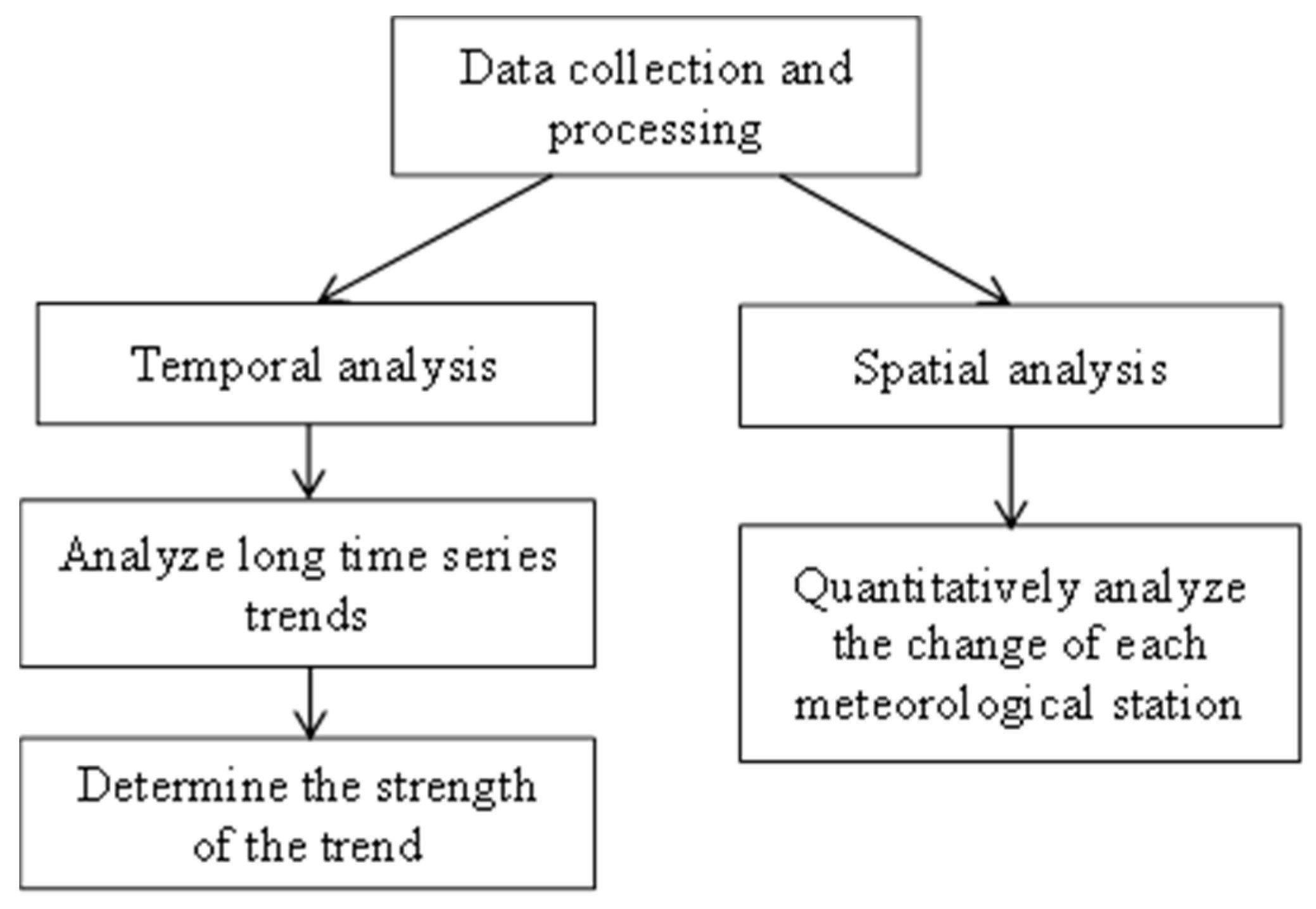
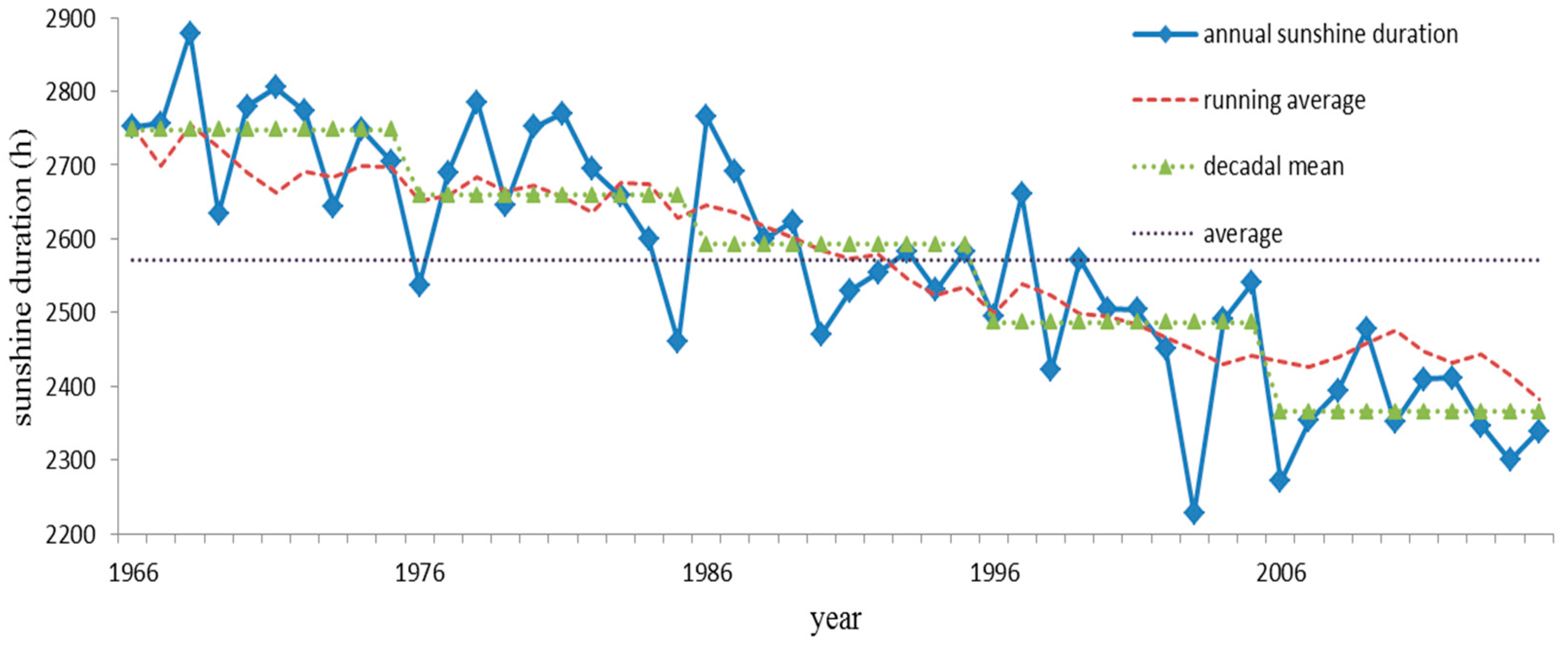


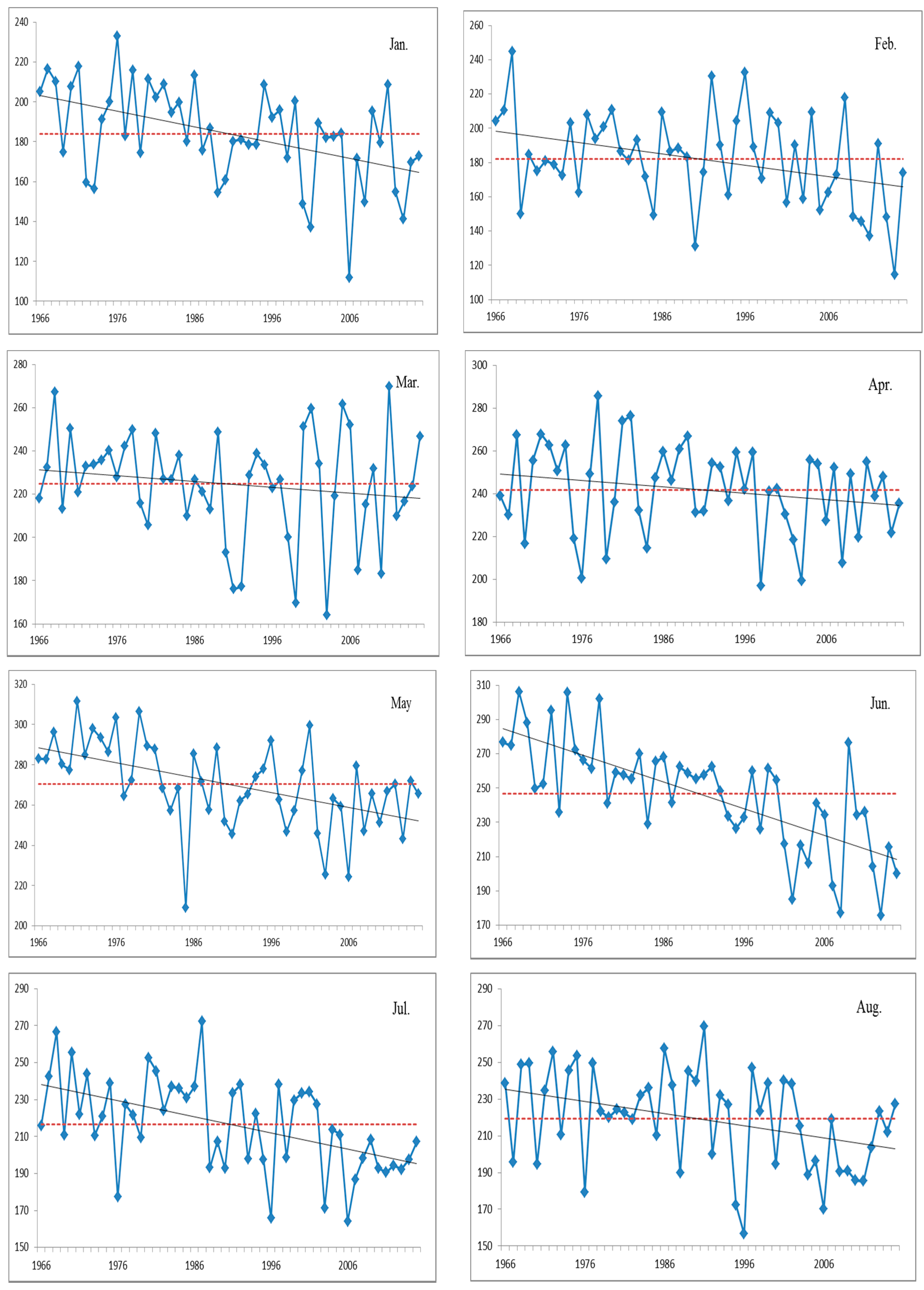
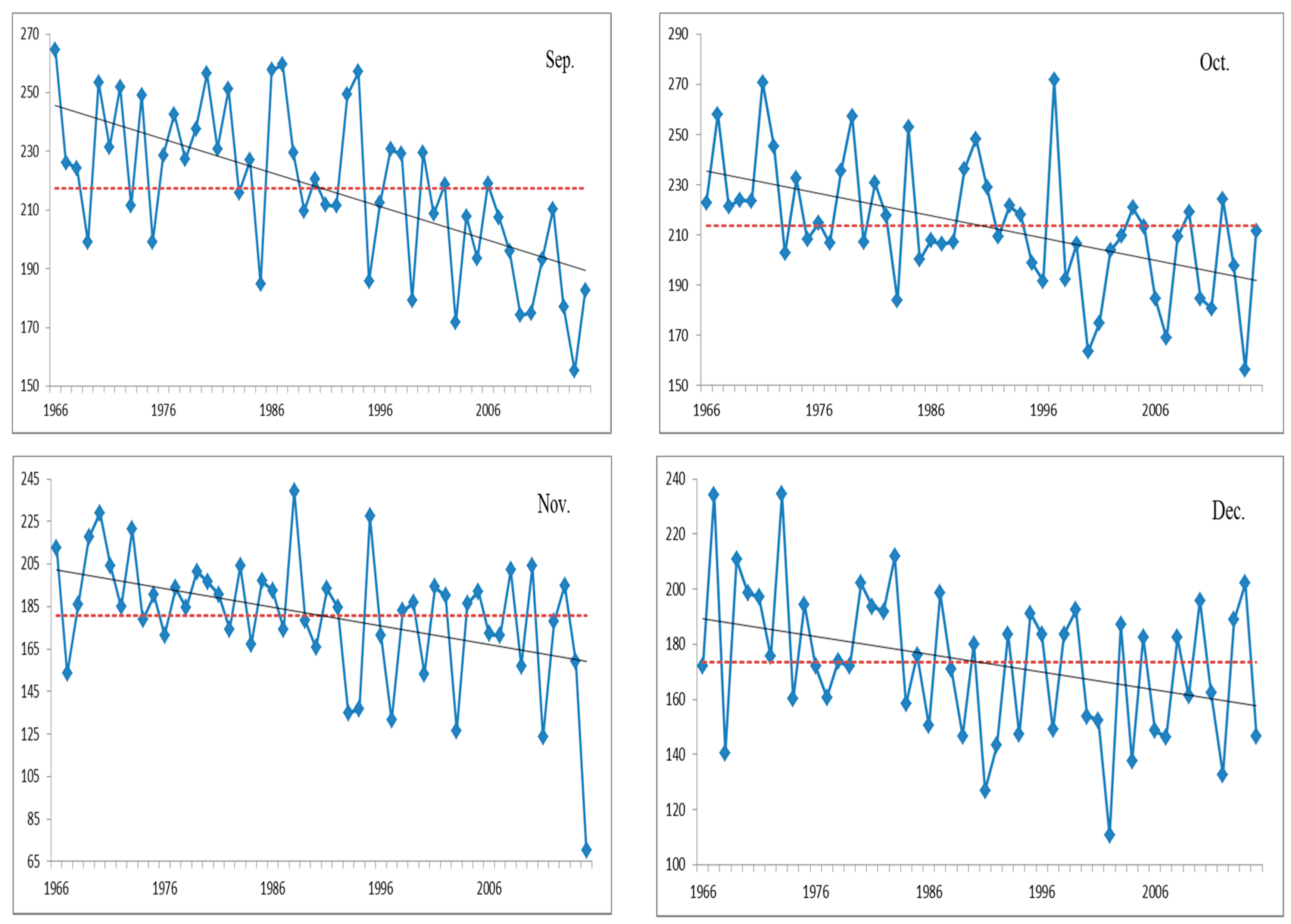
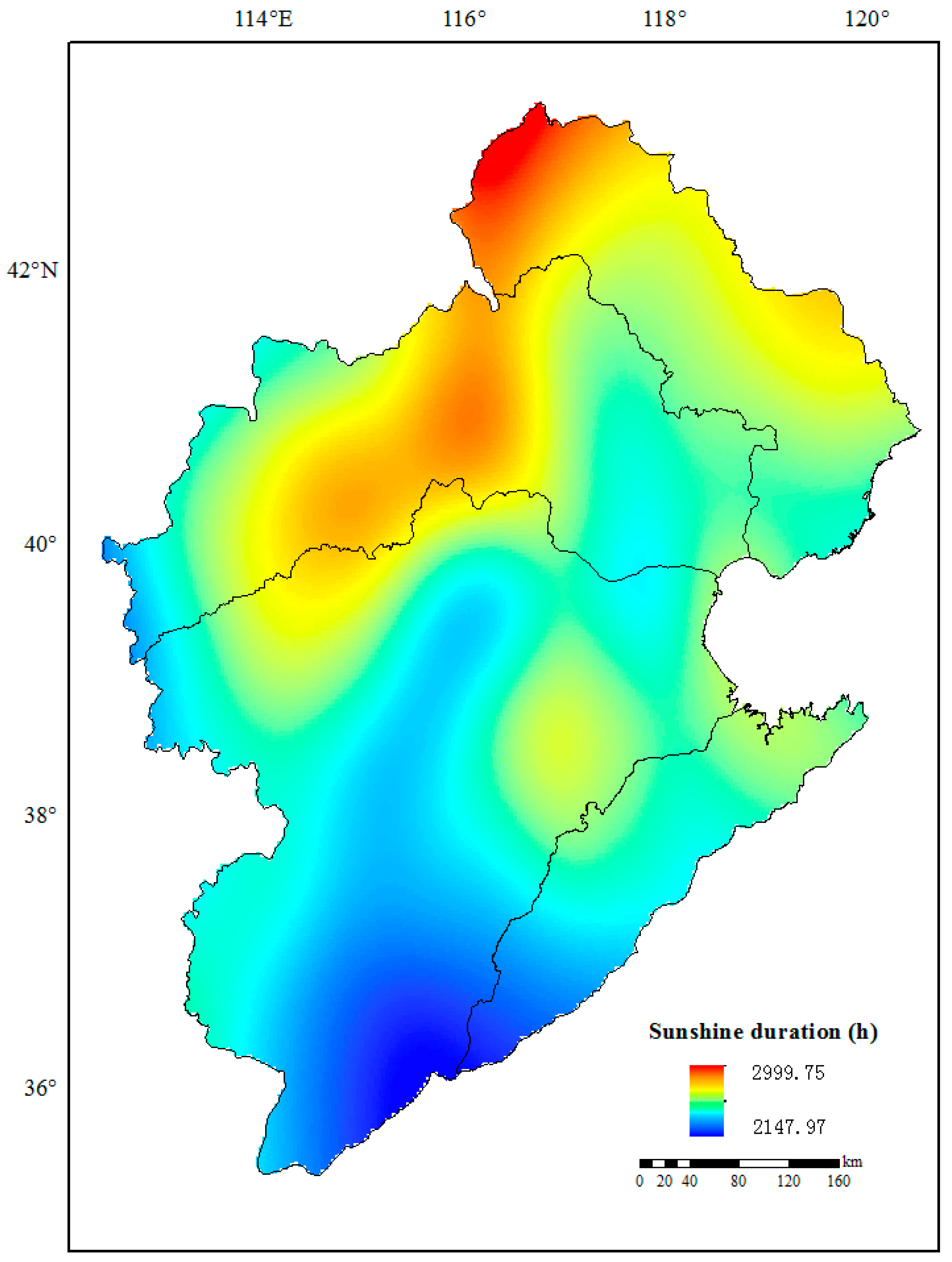
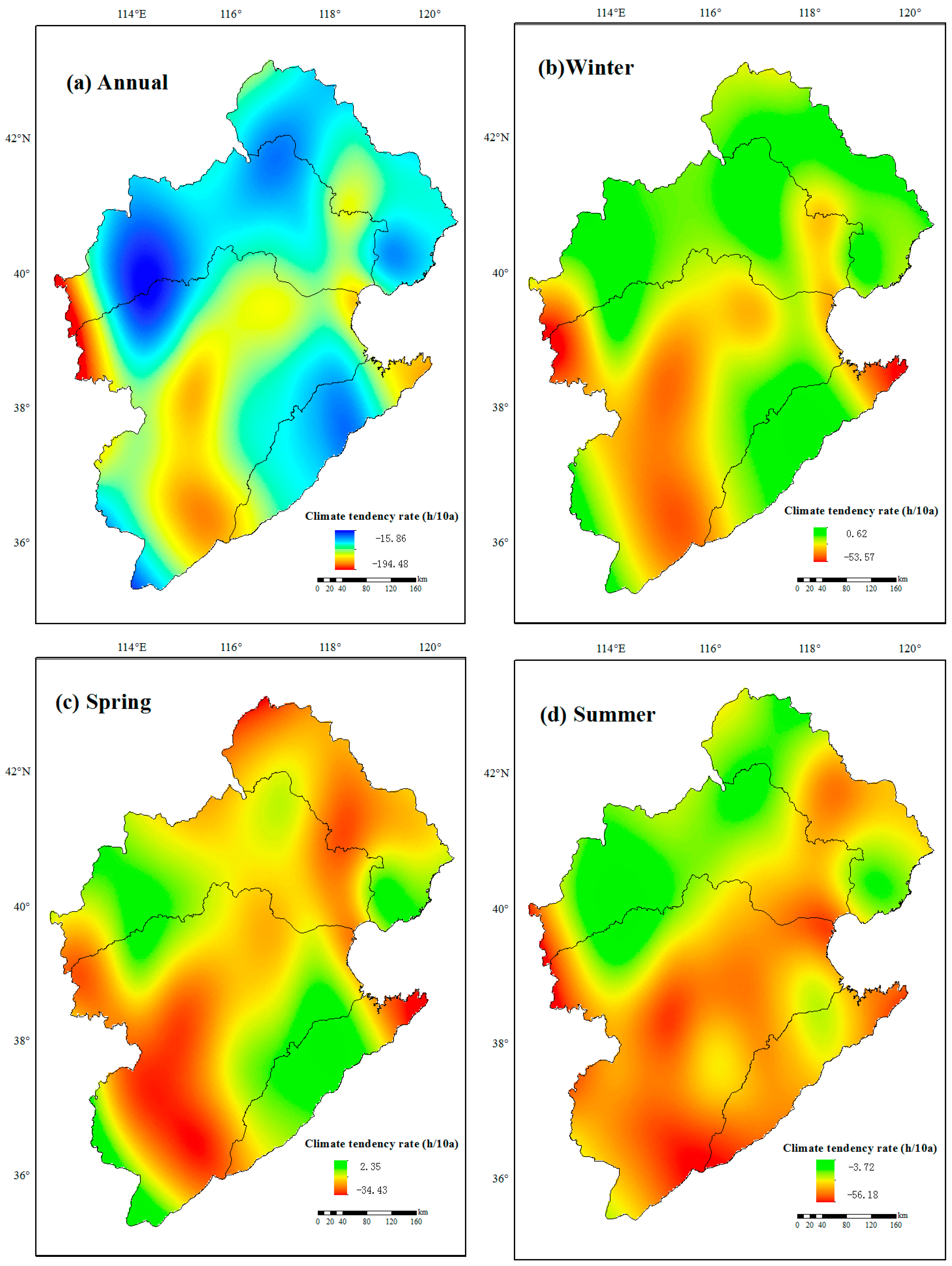
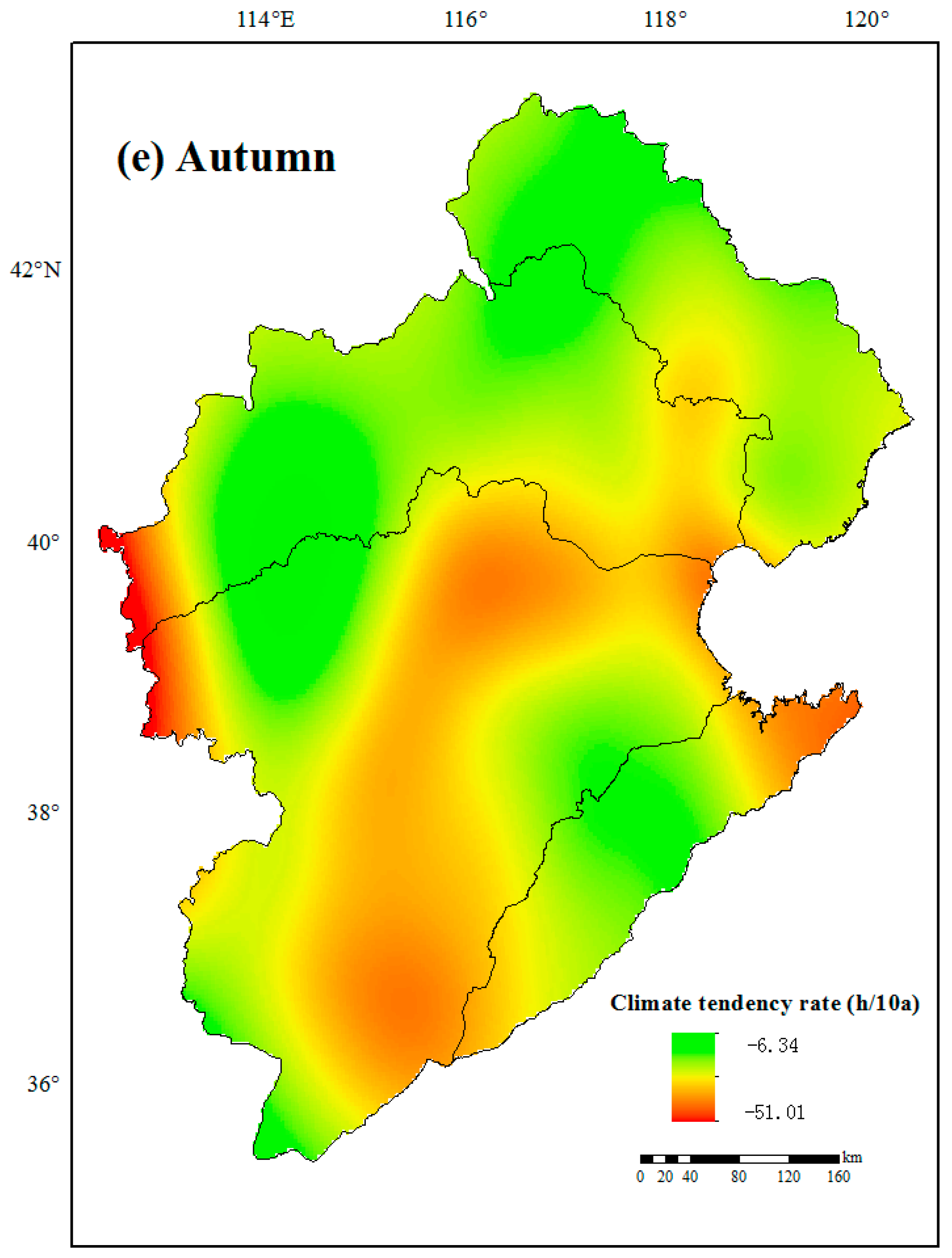
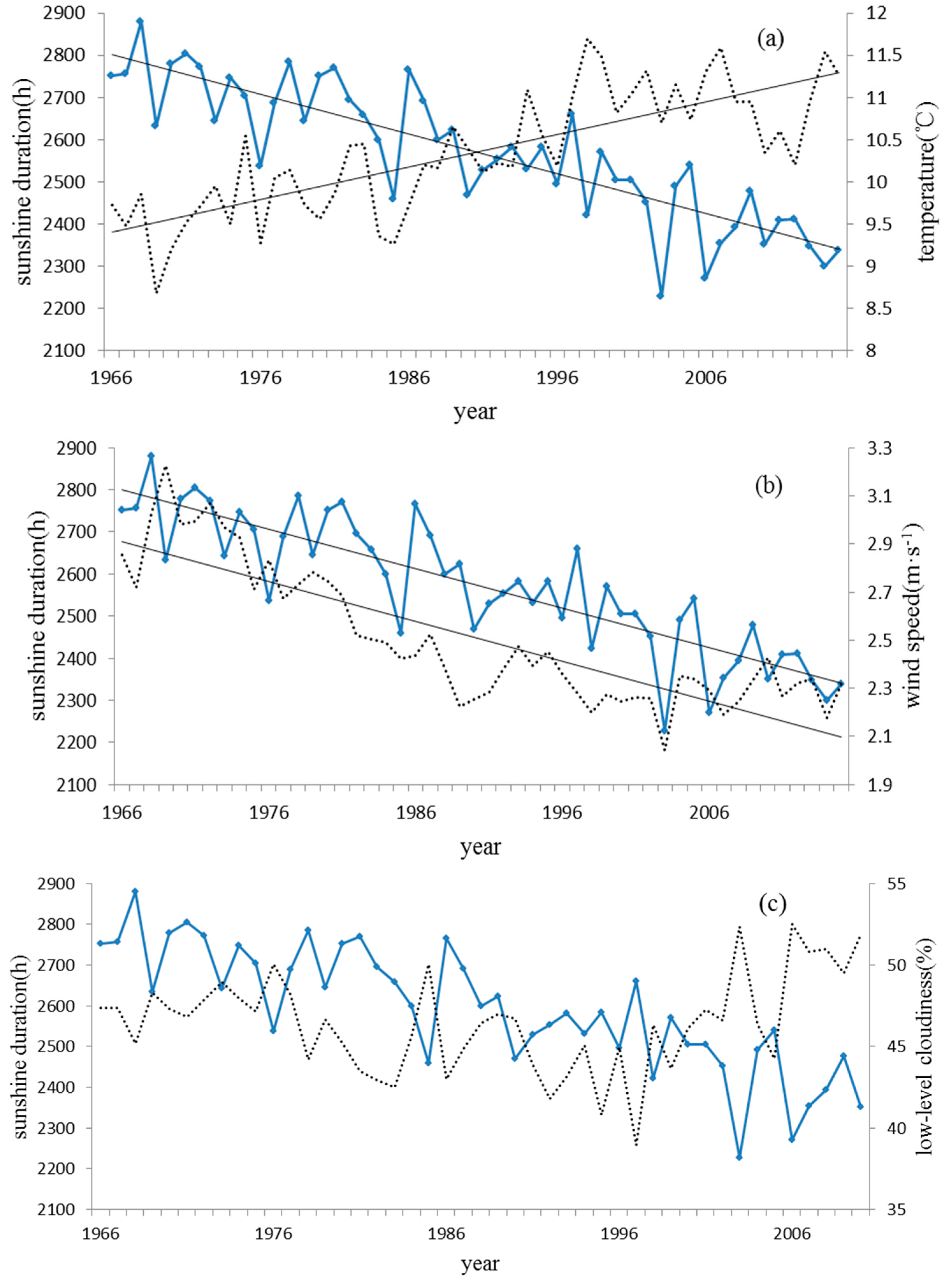

| Month | Jan. | Feb. | Mar. | Apr. | May | Jun. |
| Sunshine duration | 183.99 | 182.09 | 224.74 | 241.77 | 270.30 | 246.50 |
| Month | Jul. | Aug. | Sep. | Oct. | Nov. | Dec. |
| Sunshine duration | 216.69 | 219.20 | 217.52 | 213.62 | 180.67 | 173.39 |
| Period | Annual | Winter | Spring | Summer | Autumn | |
|---|---|---|---|---|---|---|
| Temperature | 1966–2015 | −0.50 b | −0.31 a | −0.04 | 0.004 | −0.37 a |
| Wind speed | 1966–2015 | 0.61 b | 0.61 b | 0.38 b | 0.51 b | 0.61 b |
| Low-level cloudiness | 1966–2010 | −0.29 | −0.81 b | −0.17 | −0.72 b | −0.60 b |
© 2017 by the authors. Licensee MDPI, Basel, Switzerland. This article is an open access article distributed under the terms and conditions of the Creative Commons Attribution (CC BY) license (http://creativecommons.org/licenses/by/4.0/).
Share and Cite
Ren, J.; Lei, X.; Zhang, Y.; Wang, M.; Xiang, L. Sunshine Duration Variability in Haihe River Basin, China, during 1966–2015. Water 2017, 9, 770. https://doi.org/10.3390/w9100770
Ren J, Lei X, Zhang Y, Wang M, Xiang L. Sunshine Duration Variability in Haihe River Basin, China, during 1966–2015. Water. 2017; 9(10):770. https://doi.org/10.3390/w9100770
Chicago/Turabian StyleRen, Jing, Xiaohui Lei, Yuhu Zhang, Mingna Wang, and Liu Xiang. 2017. "Sunshine Duration Variability in Haihe River Basin, China, during 1966–2015" Water 9, no. 10: 770. https://doi.org/10.3390/w9100770
APA StyleRen, J., Lei, X., Zhang, Y., Wang, M., & Xiang, L. (2017). Sunshine Duration Variability in Haihe River Basin, China, during 1966–2015. Water, 9(10), 770. https://doi.org/10.3390/w9100770






